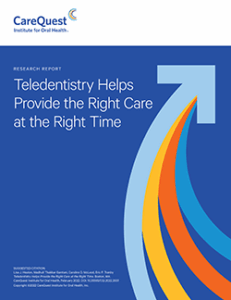Early in the COVID-19 pandemic, dental providers turned to teledentistry to triage and communicate with patients. While teledentistry was thought to improve access and reduce costs, research on it was limited — especially on the types of follow-up treatments provided after a teledentistry visit.
To address this gap, CareQuest Institute researchers examined data on oral health outcomes for patients after a teledentistry visit at oral health centers in Oregon and Washington. Key findings include:
- 6 out of 10 individuals who had a teledentistry visit subsequently had a problem-focused evaluation at their next in-person visit.
- Teledentistry visits were, on average, less expensive ($99 per visit) than in-person visits ($114 per visit).
- Teledentistry was more often used by individuals living in rural areas (13%) compared to those living in suburban (10%) or urban (6%) locations.
Beyond the pandemic, teledentistry holds great promise to increase access to care. Providers can use the modality to enable comprehensive, risk-based, and integrated care that improves quality at a lower cost.
You may also be interested in:
- Oral Health Professionals Are Ready to Accept Teledentistry, a report featuring survey results which show that providers are open to teledentistry, and that it can play a crucial role in increasing access to care and improving quality of care.
- Teledentistry: Opportunities for Expanding the Capacity and Reach of the Oral Health Care System, a report by the Association of State and Territorial Dental Directors (ASTDD) and CareQuest Institute that provides a framework to identify opportunities and strategies to incorporate teledentistry into oral health delivery systems.
- Why Teledentistry Isn’t a Fad, a blog post featuring Scott Howell, DMD, MPH, that provides advice for organizations getting started on a teledentistry program.

